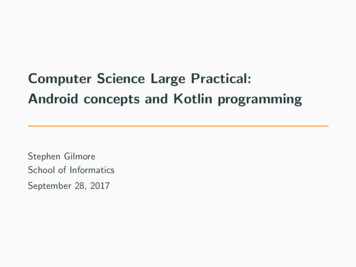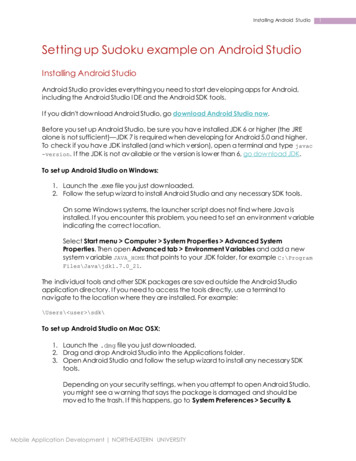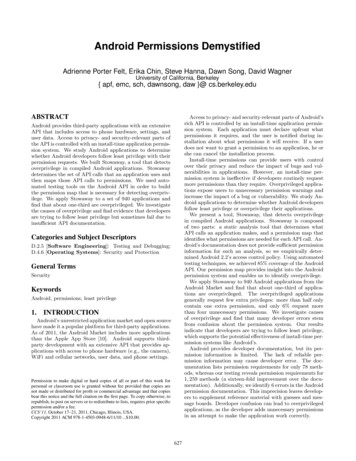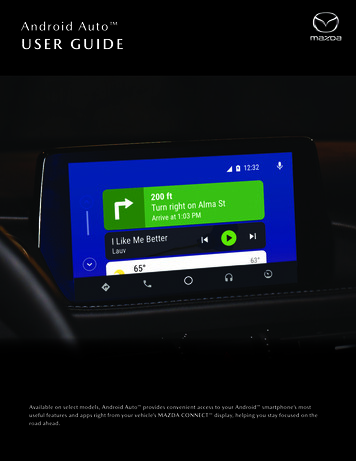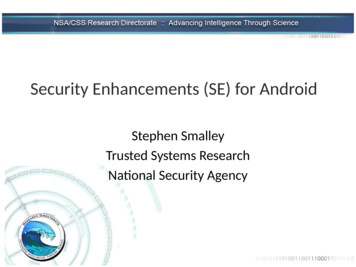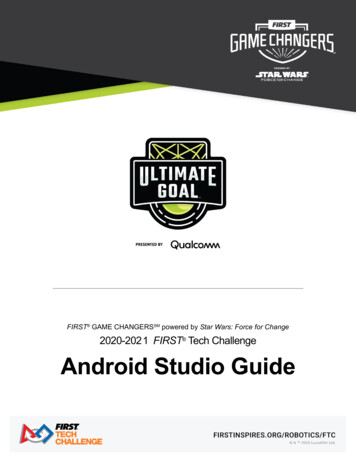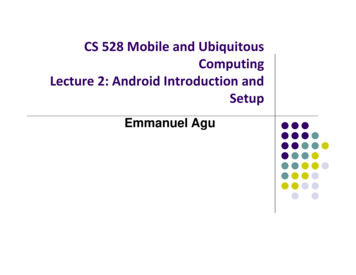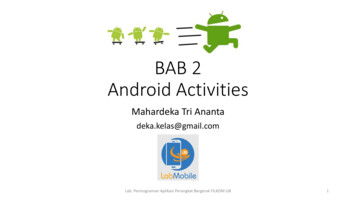
Transcription
IT 11 059Examensarbete 15 hpAugusti 2011A proposal for an Android-basedtablet client used in one-to-onecomputing in teaching environmentsAlexander RangevikInstitutionen för informationsteknologiDepartment of Information Technology
AbstractA proposal for an Android-based tablet client used inone-to-one computing in teaching environmentsAlexander RangevikTeknisk- naturvetenskaplig orietLägerhyddsvägen 1Hus 4, Plan 0Postadress:Box 536751 21 UppsalaTelefon:018 – 471 30 03Telefax:018 – 471 30 00Hemsida:http://www.teknat.uu.se/studentThe technology of today givesopportunity to completely new ways ofdeveloping educational systems for bothteaching and learning.Portable devices to reasonableprices contribute to a large majoritybeing able to acquire laptops, netbooks,smartphones and tablets.Therefore, students that usecomputers, for instance taking notes atlectures become more and more common.The educational form should, insteadof opposing and discourage the use ofcomputers during lecturing, take theadvantage of the rapid development ofthese systems to ease the way ofeducation for both students andteachers.This report will examine thepossibilities of developing this type ofone-toone computing systems, from atablet’s point of view. Where theteacher can provide, for instance, PowerPoint slides to all student’s devicesand give them the possibility to sendfeedback.An already existing system, which iscomputer-to-computer based, is builtupon this idea and developed by amaster’s student within the departmentof Computer Science at National TaiwanNormal University (NTNU), Taiwan.The task assigner of the existingproject now wants to extend this systemto work with tablet platforms as well,which will enable students to use bothcomputers and tablets for the same task.Furthermore, I will with this reportlook into the Android platform and itspossibilities for the required task andcome up with an appropriate designsolution; what difficulties that canoccur with an eventual implementation ona tablet, and also develop a suitablegraphical user interface.The result is a user interface made inAndroid for sliding through PowerPoint slides as JPEG-images, a userlogin procedure and a solution forfinding existing Bonjour services run onan actual Android device.Handledare: Greg C LeeÄmnesgranskare: Lars OestreicherExaminator: Anders JanssonIT 11 059Tryckt av: Reprocentralen ITC
Index1Introduction . 61.1The ongoing project at NTNU . 61.2Task description . 71.3Goal and purpose . 71.4Method . 81.5Delimitation . 82Background . 92.1One-to-one computing. 92.2Tablets . 92.3The Android platform and devices . 102.4Human-Computer Interaction . 103Methods and design development. 113.1User Interface . 113.2 Server-Client network model. 123.1.1Bonjour . 123.2Image Processing. 124Results . 134.1Implementation Android . 134.1.1Differences from the Java point of view . 144.1.2Network solution . 164.2Human Computer Interaction . 174.2.1User Interface . 174.3Image Processing. 204.3.1Horizontal projection . 204.4Result summary . 215Discussion . 23References . 26
oSApplication Programming InterfaceGraphical User InterfaceInternet ProtocolJoint Photographic Experts GroupMulticast Domain Name SystemModel-Controller-ViewNational Taiwan Normal UniversityReal-Time Control ProtocolSoftware Development KitTransmission Control ProtocolUser Datagram ProtocolQuality of Service
1 Introduction1.1 The ongoing project at NTNUThe task assigner at National Taiwan Normal University has an ongoingproject involving several students in different graduation stages, from seniorto master’s students. The project focuses on building a universal solution forone-to-one computing in student-teacher environments. An existing systemis built upon a Java framework for compatibility reasons. The system is stillon a development level and therefore has not been subject to any extensiveuser testing, which means that the compatibility status with other platformsis still uncovered grounds – this is where my part comes in.The server, typically being run by the teacher, has functionality that provides: changing of slides drawing on the slides with different colors, for instance, to highlightimportant areas, and collecting answers from question slides.The slides are of Power Point type, but converted into images duringruntime.The server can see all connected devices and their corresponding studentIDs, in case it wants to send any individual data. The client, on the otherhand, works as a receiver of the content sent by the server. However, theclient can send feedback to the server in forms of drawn-upon slides and alsoanswering custom-made question slides.The custom-made question slides are created on the server side with imageprocessing software. The algorithm used for this task will distinguish question slides from ordinary content. These slides will have ‘clickable’ buttonsthat provide question alternatives. The students can thereafter press any ofthe answers of choice and the feedback will be sent to the teacher with thecorresponding student ID.6
Both the server and the client are embedded within the same executable andas you start the program the option to choose between ‘Server’ and ‘Client’is shown to the user.This kind of interaction between teacher and student is ideal, for instance,when the teacher wants to know how the class is progressing in a certainfield.1.2 Task descriptionInitially, and as stated in the project proposal, the task description was morefocused on finding a suitable GUI approach, solve some algorithmic problems regarding the image processing part and setting up the networking between the devices using Bonjour. However as the project progressed a lot ofissues regarding the network solution appeared. It appeared that the Androidplatform, on which the solution was supposed to be built, had some incompatibility problems with the network protocol Bonjour1 and also problemswith other solutions based on Zero-configuration. So after extensive researching of the Android platform’s possibilities and limitations, the task hascome to change into something more of a User Interface-oriented kind,which also the task assigner approved with. Therefore and foremost, I willlook into how the implementation could look like and also propose a designsolution, a GUI. Secondly, if there is time, implement further functionality.1.3 Goal and purposeThe purpose of the study and research will be to: evaluate the development of a tablet-based client, with Android asthe platform of choice, evaluate how different solutions could look like when it comes to thenetworking part between client and server, investigate how an appropriate User Interface would be designedand how it would best suit this kind of system, and finally look into possible image processing functionality of the client andhow to solve this in a suitable manner.The purpose has been modified from the initial plans.1For a description of Bonjour, se section 3.2.17
1.4 MethodBy a thorough study of the Android platform architecture I will try to find adesign solution suited for the purpose. I will do research on if there are anyeventual problems with the solution and how, if they exist, should be solved.Studies will also be made in the field of Human Computer Interaction inorder to find a good graphic and interactive solution, for the purpose ofproviding a user-friendly experience for the users.The task assigner will provide an Android 3.0-based device for testing purposes and evaluation.1.5 DelimitationImplementation issues may occur since the Android platform is still on animmature stage and it still lacks extensive documentation. And also becauseof the somewhat unexplored area of this thesis’s focus, it may be hard to findsources that will support me in the research. This may become an obstaclewhen it comes to find a proper implementation solution.Although the Android platform uses Java as programming language, it ishugely different to develop for mobile devices than computers. Componentlifecycles, memory management, threads etc. in mobile development are alsosomewhat unexplored areas for me.Since my solution is dependent on another student’s solution and code, theserver, which is developed on a different platform, compatibility issues mayoccur. The project is also dependent to actually be tested on a real devicesince the emulator supplied by the Android SDK environment does not allownetwork interaction.8
2 Background2.1 One-to-one computingOne-to-one computing is defined as “a student uses at least one computingdevice for learning” [8]. In teaching environments this means that everystudent and teacher possesses a computer, Internet and software that allowsevery user to be accessible. The term “computer” means PC, laptop, netbook, hand-held devices and tablets [10].The formal definition stated above is quite old, from a time where studentspossessing their own computer are considered somewhat unusual. Nowadays, the case is different since most people already have their own laptops,so supplying them with either software to be used on their own devices oreven supplying them with computers in some cases, is a problem of no concern.2.2 TabletsSince the development of more and more sophisticated smartphones the interest for the hand-held computer market has increased. The introduction of,among others, Apple’s iPad did not only change the market but also createda whole new way of using the new generation of tablet computers. The sophisticated touch screens, the high-end hardware and long battery life enables countless of ways and environments for these devices to be used in.Other major companies as Acer, Asus, HTC and Motorola also accompaniedthe trend and created their own similar devices. The main differences between these devices however are foremost the operating system, in whichthere are two major participants competing for the customers, Apple’s iOSand Google’s Android. There are also some Windows based operating systems on some devices, although these have not gained as much recognitionon the market so far.With the fast growth of these kinds of systems and especially with the easeof use and user friendliness they provide. The fields that these devices couldbe used in are a very interesting and current topic.9
2.3 The Android platform and devicesAndroid [3] is a software platform initially developed for smartphones, but isnow also developed for tablet use. Android’s SDK supplies tools and APIsnecessary to be able to develop for the Android platform, with Java as primary programming language. Android is based on a modified Linux kernel.The operating system’s software consists of Java applications that run on anobject oriented application structure. Android was developed by AndroidInc., which later was bought by Google the year of 2005.An “Acer Iconia Tab A500” device is used for testing and is based on theHoneycomb 3.0 operating system for Android. It has a 10.1-inch screen witha resolution of 1280 x 800 WXGA and a 16:10 aspect ratio.2.4 Human-Computer InteractionWhen developing for mobile devices and tablets the importance of HCI becomes more significant. On a computer screen the resolution is high and theuser navigates using the cursor, which gives very high accuracy. This enables buttons, text and graphical components to be very small. It also enablesa lot of information to be crammed into the workspace without it feelingcluttered. When it comes to mobile and tablet design we have to rethink ourlayouts a bit more thoroughly. The workspace is an issue and choosing theright content to show in the right moment becomes crucial.The importance of a seamless mobile system becomes more important thanfor traditional computer environments. The user should not need to lookaround in an application for different functions, as we are used to with today’s computer software. For a mobile device the intuitivity of a solution isthe first most important factor when using an application.10
3 Methods and design development3.1 User InterfaceTo find a suitable User Interface for the purpose of creating a user-friendlyenvironment, I will look into mobile and portable device guidelines suppliedby Android and information from previous courses taken in Human Computer Interaction.An initial proposal was made during early stages of the research process, thisimage is actually an image mockup based on an iPad framework, Figure 1,It was only intended to be used as a proposal and a way to build further ideasfrom. On the top a progress indication and the four buttons represent, fromleft to right; send slide to server (teacher), previous slide, next slide and drawon slide.Figure 1. A initial proposal of the layout.11
3.2 Server-Client network modelThe obvious model for this type of application is of course a client-servernetwork model. Since the existing server is built upon a solution based onthe Bonjour protocol and thus on UDP, the idea is that the client will be implemented to seamlessly connect with this system. When the user starts theapplication a discovery service starts up in the background looking for theserver and connects to it. What I will do is to explore how this could besolved using Android in conjunction with the existing server.3.1.1 BonjourThe Bonjour networking protocol [11] is an implementation of Zero configuration, a protocol for discovery of network services. Bonjour can discoverdevices such as printers, computers and other devices’ services that areavailable on a local network.Bonjour uses something called multicast Domain Name System, mDNS[12]. This means that each computer on the local network stores a list ofDNS resource records and then joins the mDNS multicast group. When aclient wants to know the IP address of other devices, given its name, themDNS client sends a retrieval request to an already known multicast address, the device with the corresponding record will reply with its IP addressand port number. This is then used to create a socket connection, using eitherTCP or UDP.3.2 Image ProcessingThe client as we know is provided with the broadcasted slides from the server. Some of these slides contain information that the users can interact with,for instance multiple-choice questions. First of all what needs to be done isto convert the Power Point-formatted slides to a suitable image file type, inour case JPEG is fine.To be able to distinguish what is a question slide and what is just an information slide we use something called horizontal projection [6] within imageprocessing.To complete this functionality within the client’s implementation we wouldprobably need library functions for the Power Point to JPEG conversion.Then it is necessary to apply an algorithmic solution for the horizontal projection to determine where to create clickable links, possibly using histograms to distinguish text from background.12
4 Results4.1 Implementation AndroidThe Android framework is based on one or more application components;activities, services, content providers and broadcast receivers. In this application we will focus on activities and services.Content providers manage the data stored within the system, such as anSQLite database, content on the Internet or another local storage location. Atthis stage of the implementation Content providers is not necessary. Secondly, broadcast receivers are components that respond to announcements madeby the system, such as; a picture has been captured or the battery is low.These broadcasts are also of little concern for us at this stage.Back to the activities, an activity represents a single screen with a user interface. I implemented three activities; one main screen, which handles thelogin process which requests a user ID, the discovery service for connectionto the server and the actual slider part with the pictures. The user can in theory jump between these activities by pressing the ‘back’ button (applicationicon) supplied by the OS and then start certain activities again, figure 2.Figure 2. The three main activities.13
The connection between activities is something called an Intent object; itbinds individual components together and creates a bridge between them. Itprovides a means for communication between activities, by passing alongmessages for instance. In example 1 you can see the code that creates a button that in turn creates the Intent object and bounds it with Slider.class andstarts its ges*/ButtonstartSlider oidonClick(Viewview){IntentmyIntent ivityForResult(myIntent,0);}});Example 1. Code to create a button that creates the Intent object and bounds itwith Slider.class and starts its activity.The discovery service is actually at this stage a foreground activity and not aservice. The reason for this is that it is easier to work with activities in theforeground and make sure they work properly before we transfer them towork as a background service. However, the Android implementation guidelines discourage the use of network activities in the foreground, as they tendto consume too many resources. Although as a proof of concept, we acceptthis at the time being.4.1.1 Differences from the Java point of viewWhat differentiates typical Java programming that I am used to, from the oneused when programming for Android is that of the different applicationcomponents, mentioned before. When the Main.class is started for instance,we need to extend the Activity object to create something visual, a firstscreen. Then what we need to do here is to override the onCreate methodwith says what we shall do with our new activity object. In this case webound the activity with a layout file called main.xml that structures visualobject such as buttons and text fields for instance, see example ayout.main);.}Example 2. Code that sets the visual properties, run when Main.class is started.14
Below is a graphical representation of the activity lifecycle, see figure 3.These methods are all part of the Android API and are crucial in the management of activities. This framework is built upon Java as mentioned buttightly connected to hardware functions within the Android devices, this isone of the core differences when programming for Android compared withregular Java programming.Figure 3. The activity lifecycle. (developer.android.com).15
4.1.2 Network solutionThe initial idea was for the client to have a built in service discovery algorithm for picking up the server’s broadcasted IP. Connect to the server, let itsuser send their student ID and begin receiving content from the server, inform of previous mentioned Power Point slides. As it turned out the Androidplatform does not really support the Bonjour library, which the server uses,this because of the simple fact that there is no implementation made for Android by Apple [1].What some developers has managed to do is to use a software library calledjmDNS [7], which is a Java based library built for Zero configuration communication. The jmDNS works as a broadcast search for devices, in similarity with the Bonjour library.Initially I only had access to a HTC device running Android to test the already existing solution that was built in Java by the other student, however itseemed that these devices had some bugs [4] when it comes to DNSbroadcasting [5].Another issue is that, even though jmDNS and Bonjour are built on the sameidea of Zero configuration, the API is totally different and would require there-writing the methods of the jmDNS library to function properly with theBonjour library methods.In a latter stage of the work process I acquired an Android 3.0 tablet fromthe task assigner to test the jmDNS library for service discovery. It turnedout that the Android device actually could find other services of Zero configuration kind in the vicinity when I did a live test. However, although theone-to-one computing server was running next to the device, the tablet clientwas unable to successfully pick up its broadcast.With some consultation with the task assigner and the other student whodeveloped the server we agreed upon leaving the networking part aside, andcontinue as if it had worked. One solution to this problem could to be implementing an alternative way of connecting to the server, using a directsocket connection with the server’s IP given beforehand. In other words thiswould mean to hard-code the connection on the client to the server, bypassing the broadcasting part. Doing this would require the server code to be rewritten and tested in close conjunction with my system. However this wassomething that was beyond my control and influence and will probably beconsidered in a future version of the server software.16
4.2 Human Computer Interaction4.2.1 User InterfaceSmartphone applications are generally designed to show as little informationas possible to make them easy to navigate and understand. However when itcomes to tablets we have to re-think this general ideology a little bit. All of asudden we are supplied with high resolution and large screens, but still withsmartphone features. We are in this situation stuck somewhere in a boundarycountry between a smartphone and a computer.According to Android UI Design Patterns [9] the general idea of “less ismore” is emphasized. For instance, it is encouraged that not more that four tosix possible choices, or buttons, are presented on each screen to avoid cluttering. However since they refer to smartphones and not tablets using Android, this is not really our concern. However we should still keep this inmind since the user still uses its fingers to navigate and there shall be enoughspace around clickable items to make the user feel comfortable and notafraid to miss-click. In our case the application does not really have a lot offunctionality so staying within the guidelines is done with ease.After the connection is established to the server an input text box appearscentered on the screen, asking for the student ID-number, the virtual keyboard is set to appear. The user input its ID number and presses confirmwhich is a button directly under the input field, see Figure 4.The slides sent from the server appear on the screen, and the device is nowconnected to the server and the teacher can broadcast all slides to the students.17
Figure 4. The Login screen.What is shown on the screen is now the current slide and the Android actionbar, located at the top, with a few buttons. If the user presses anywhere on aslide image a toast message appear, displaying the number of the currentslide out of the total number, for instance ‘3 of 14’. A toast message is aquick little message that pops up on the screen and stays there for a briefperiod of time, then fading away. This is a very useful way of informing theuser of the current progress through the slides requiring no additional interaction from the user.On top of the screen is where the action bar is located. To the left of it is theapplication name with a corresponding application icon. Pressing this iconwill bring the user ‘up’ one level or back to the Android OS menu if the useris on the root level of the application, otherwise just back to the previousactivity. On the rightmost side are four buttons, Previous, Next, Draw andSend, see Figure 5. The Previous and Next are self-explanatory, however theDraw and Send buttons, need some explanations.When the user presses the Draw button a toast message appears for a briefmoment indicating that the user is in Draw mode and they will be able todraw on the screen with their fingers, and when they are done they simplypress the Draw button again. This could, for instance, be used to mark wordsor point out things of interest to the teacher.18
Figure 5. The Slide Screen.When the user presses the Send button, the actual screen the user sees is sentto the teacher and a status toast message displays that the action is processing, ‘Sending slide.’. The feedback is given since it is important toshow the user what is going on when an action is commenced.To slide from one image to the next or previous image the user just swipesthe finger in the opposite direction of the new image, e.g. swipe finger to theleft for next image.The slides are shown as fixed size images, in order to fit the resolution of theactual Android device. Therefore they will look good on any 10-inch screenwith similar resolution. Although for the final application to be consideredready for launch, it needs to be scalable to handle different resolutions,screen sizes, new models etc. since we don’t want to restrict the system tojust tablets of a fixed screen size.Android has thought about this and implemented good solutions to handlethese kinds of matters. The use of XML-sheets for the layout descriptionmakes it easier to organize your code and follow the MCV-standard if usedcorrectly, in other words avoiding putting layout features in the model ratherthan in the view. This makes it fairly easy to implement different stylingschemes and layouts for various kinds of DPIs, as Android call it.As most tablets have gyros they can sense their position, if they are held inlandscape view or portrait view.19
Since the application cannot really use this functionality to its advantage inits current stage, the orientation detection is turned off. Another reason isthat the most common way to look at a Power Point slide is in the landscapeorientation, so in order not to confuse the user we keep to this well accustomed tradition.Each application also comes with something called an AndroidManifest.xmlfile, the purpose of which is to setup a set of rules and permissions for theapplication, for instance, which platform-version the application is designedfor. Additionally, in our implementation, the manifest file is used to enablepicking up Wi-Fi-multicast signals, which is turned off by default to savebattery life.4.3 Image Processing4.3.1 Horizontal projectionHorizontal projection is done by first detecting the orientation of a binaryimage; the detection is based on the vertical and horizontal variances on animage. In our case we know that the orientation is horizontal from the beginning, which eliminates the need of orientation detection.Then by using an algorithm [13] that determines what is foreground andwhat is text; we are able to produce a projection histogram based on the horizontal and vertical pixels. Then by applying a threshold to the histogram wecan determine where the actual text is located on the Y-axis. Finally, bymeasuring the height of the image we can predict where these clickable areasare located and create links based on their location.In example 3 we can see how an algorithm for scanning through an imageand extracting the pixel values and putting them in a vertical and horizontalarrays. These arrays can later be used to create the histograms and determinewhere the text is located on the image in order to create the links.20
apimage){intW image.getWidth();intH image.getHeight();int[]horProj newint[W];int[]verProj newint[H];for(intv 0;v W;v ){for(intu 0;u H;u ){intp image.getPixel(u,v);horProj[v] p;verProj[u] p;}}}Example 3. A code sample that calculates the sum of the vertical and horizontalpixels.There is a library called Apache POI [2] for Java, which has the functionalityto convert a Power Point slide into a JPEG image. Since we need to have anactual image to work with for the horizontal projection, this is a crucial part.However, after some research, it turned out that the POI library is
2.3 The Android platform and devices Android [3] is a software platform initially developed for smartphones, but is now also developed for tablet use. Android's SDK supplies tools and APIs necessary to be able to develop for the Android platform, with Java as pri-mary programming language. Android is based on a modified Linux kernel.


